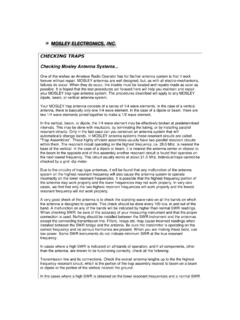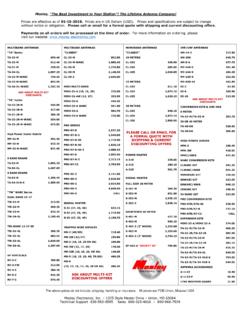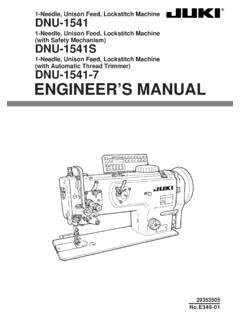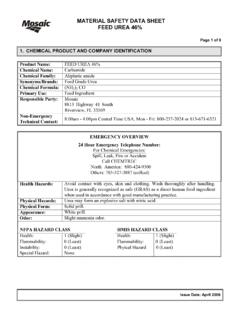Transcription of COAX AND FEED SYSTEMS Feed Systems - The Simpler, The …
1 COAX AND feed SYSTEMSFeed SYSTEMS -The Simpler, The popular belief, linear radiators, normally employed in 2 and 3 element parasitic arrays,have a driving point impedance of close to 52 ohms when open at the center. To feed such aradiator it is only necessary to connect a 52 ohm line at this point to achieve the best possiblematch of line to , because of certain design characteristics, some beam antennas require elaborate and,sometime, unstable matching devices such as Gamma or T-Match SYSTEMS or variations of thesesystems. Such devices are usually difficult to adjust and to maintain in adjustment when used inmulti-band TRAP MASTER beams, however, are so designed as to not require any unwieldymatching arrangements.
2 Mosley beams are fed by connecting the line directly to the open centerof the radiator. Thus, an excellent match is achieved over the entire width of each Ham bandresulting in extremely low SWR near resonant frequencies of each band and the ability to rangefrom one end of the band to the other without excessive eliminating such matching devices, MOSLEY TRAP MASTER beams provide their users withstable and dependable operation without the necessity of frequent trips to the roof or up the towerto make TRAP MASTER AND POWER MASTER Discussion of Beam Antenna feed SystemsAmong those Hams interested in beam antennas.
3 Many are concerned with the feed is for these Hams that we shall attempt to explain the wonderfully simple-yethighly efficient- feed system used in both theTrap Masterand thePower Masterseries ofMosley beam beliefs that a balanced radiator element cannot be fed with an unbalanced lineand that theimpedance at the center of the element is not of suitable value to permit direct connection of a 52ohm coax line are not always will show, with authoritative references, that antennascanbe designed to take advantage of the simplicity of such a system and still provide low VSWR over a broad bandwidth and a symmetrical radiation numbers will refer to theARRL Antenna Book, seventh voltage distribution over a half-wave radiator is shown inFig.
4 Voltage is zero at thecenter, a ground may be placed at this point. (Page 26)There are a variety of methods for introducing energy into the balanced line may beconnecteddirectly to suitable points at each side of the grounded element center-a methodcommonly called thedeltamatch or, with slight modification, connect an unbalancedline to a grounded un-split element, thegammamatch from grounded center toa suitable point atone side of center may be , the element may be split at the center and fed with either a balanced line without aground at the center or an unbalanced line with or without a ground at the anunbalanced line and ground onboththe outer conductor (coax braid) and antenna center, avoltage introduced just off center in the position of the power source (Fig.)
5 B.) will introduce avoltage in this excited side, as the other half of the antenna element an integral partof the circuit, voltage will appear as indicated by the dotted the end of the feed line isfundamentally the same as a power source it may be replaced in the circuit, (Fig. C.), resulting ina balanced antenna fed with an unbalanced ground at the center helps to minimizestray feed line currents to achieve the balance pattern. (Pages 98-100) (See, also, page 224, ).Curves onpage 169, Fig. 4-51, show how a three element beam, by correct tuning and elementspacing, may present a feed point impedance of from 10 to 70 course, MOSLEY beams are tuned and spaced to present 52 ohms at suitable tuning points with low VSWR overthe entire bands of operation and to achieve proper voltage distribution for a balanced CLASSIC feed "Barney" St.
6 Vrain, W0 PXES ince the introduction of multi-frequency beams, the method of feeding such antennas has beena subject of much the MosleyTrap MasterandPower Masterbeams wereintroduced, Mosley Electronics ran a series of advertisements in the technical magazinesexplaining the method that time we have tried a wide variety of feed systemsendeavoring to improve on the original Other feed SystemsIn testing, we found a three-band gamma system ineffective without isolation networks whichresulted in a feed system cost about equal to the antenna cost; with a system using hairpins, thecost proved low butthe system did not provide a better match that the original Mosley became quite clear to us that the Mosley system was hard to beat, for we had foundonly one slight disadvantage: the elements needed to be stagger tuned to raise the feed pointresistance from about 30 to 50 slight detuning, which proved advantageous inincreasing bandwidth, brought about, in turn, a slight gain loss of about to db.
7 Classic SystemIn order to give hams a new choicein beam matching SYSTEMS and an antenna featuringmaximum gain with increased bandwidth, we devised the matching method used on our Classicantennas-Balanced Capacitive Matching (Patented)-a method which takes advantage of theprinciple that antenna resistance at the center driving point increases s the antenna No. 1 shows the radiator element of a three-element beam at resonancehaving an impedance at the driving point (ZA) of about 30 + J0 the element is madelonger, ZAcan be raised to about 50 +J50 ohms (Figure No. 2).Since the reactance is inductive,it can be cancelled with a series capacitor of 50 ohms reactance, leaving 50 ohms feed pointresistance (Figure No.)
8 3).Series capacitors used on the Classic antennas are made by insertinga suitable length of heavily insulated wire into each half of the element tube at the are terminated in a plastic tube enclosure with a type 'N' or type 'SO-239' connector forconnection of the coaxial isolate the outer coax conductor from ground, the coax line iscoiled for a few turns near the antenna is designed to prevent the very unlikely effect of" feed Line Radiation."Conversion to Other BandsClassic beams are not designed for 40-meter or other conversion.(Except the CL-33-M WARC).The Classic feed system has a fixed capacity which is not easily capacity is nothigh enough for the antenna to operate on 40 meters without making the element engineers at Mosley designed the Classic feed to give the ham increased bandwidthand extra gain on all is our conviction that discriminating DX'ers will find the ClassicBeams specifically suited to their needs.
9 (NOTE:The CL-33-M can be modified to add 12/17,then 40-meters is Classic feed system is replaced with the Mosley MatchingSystem).











